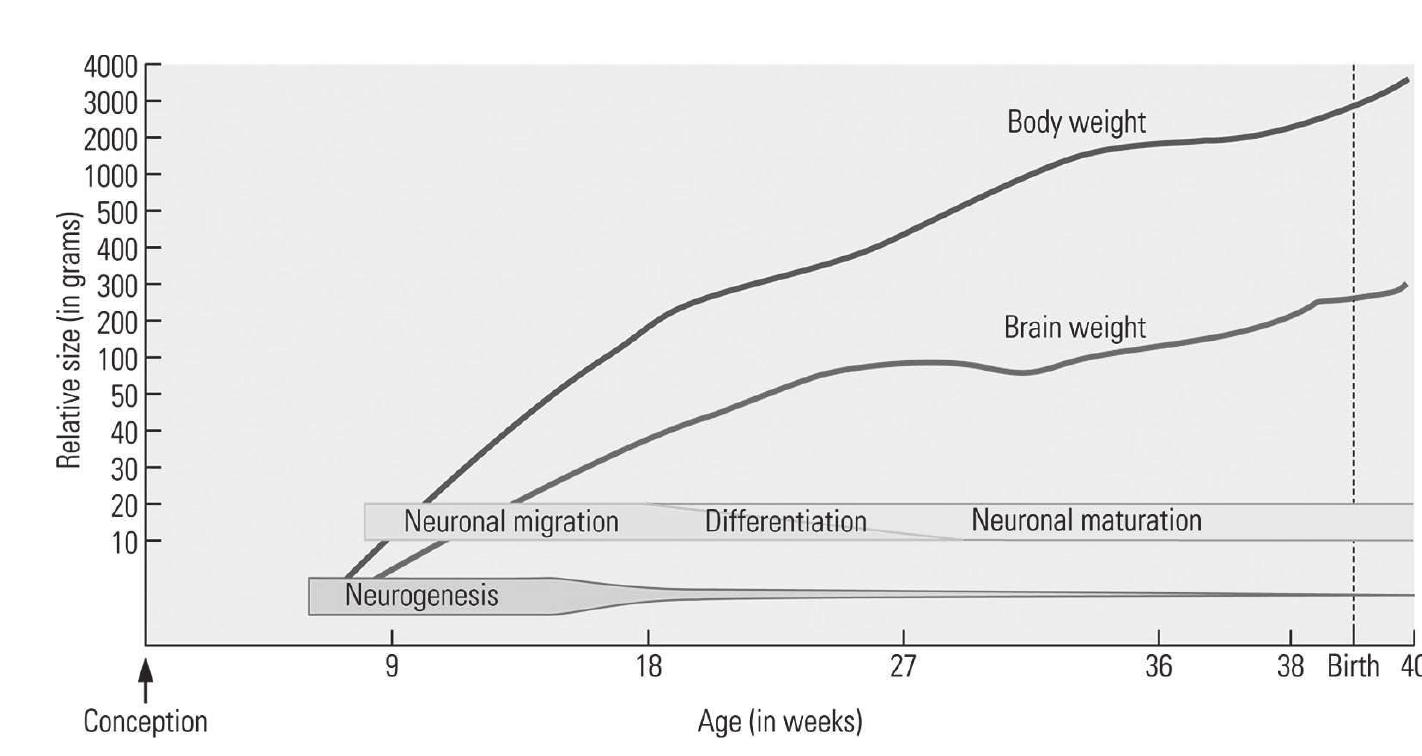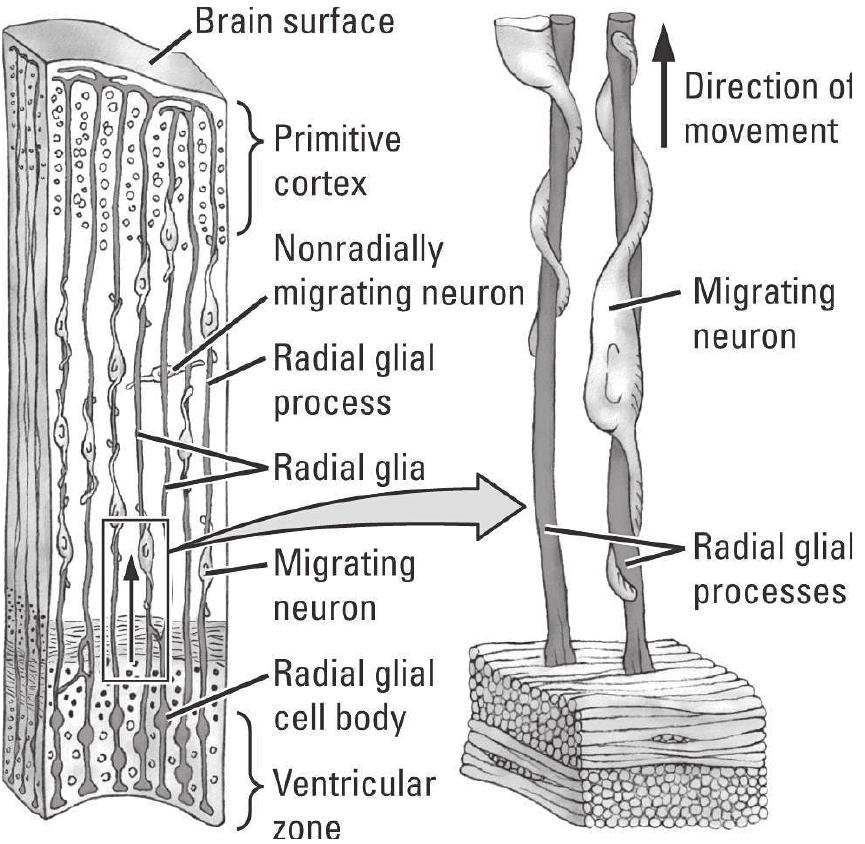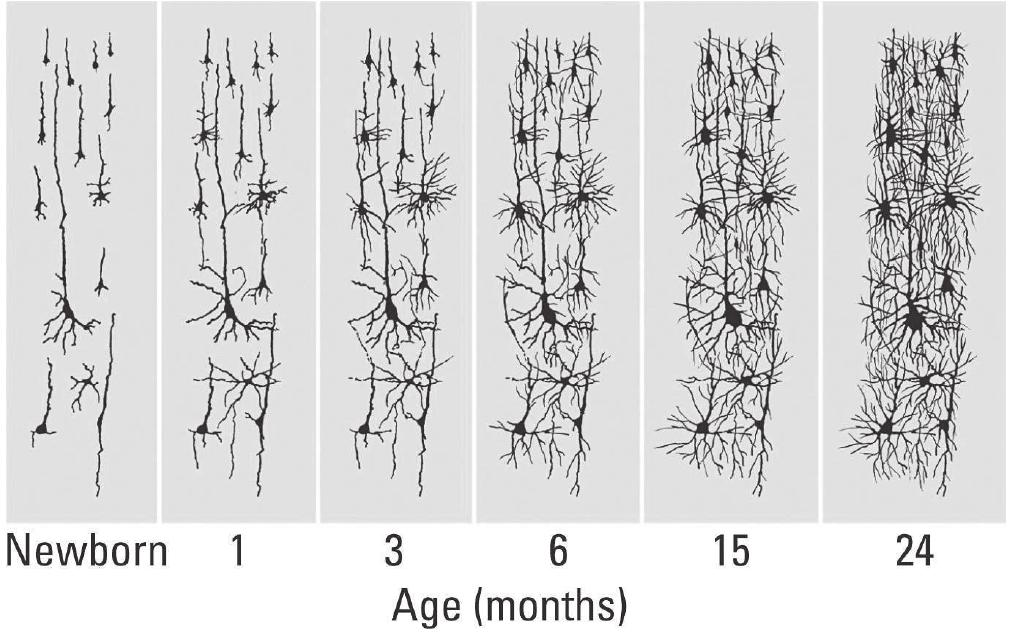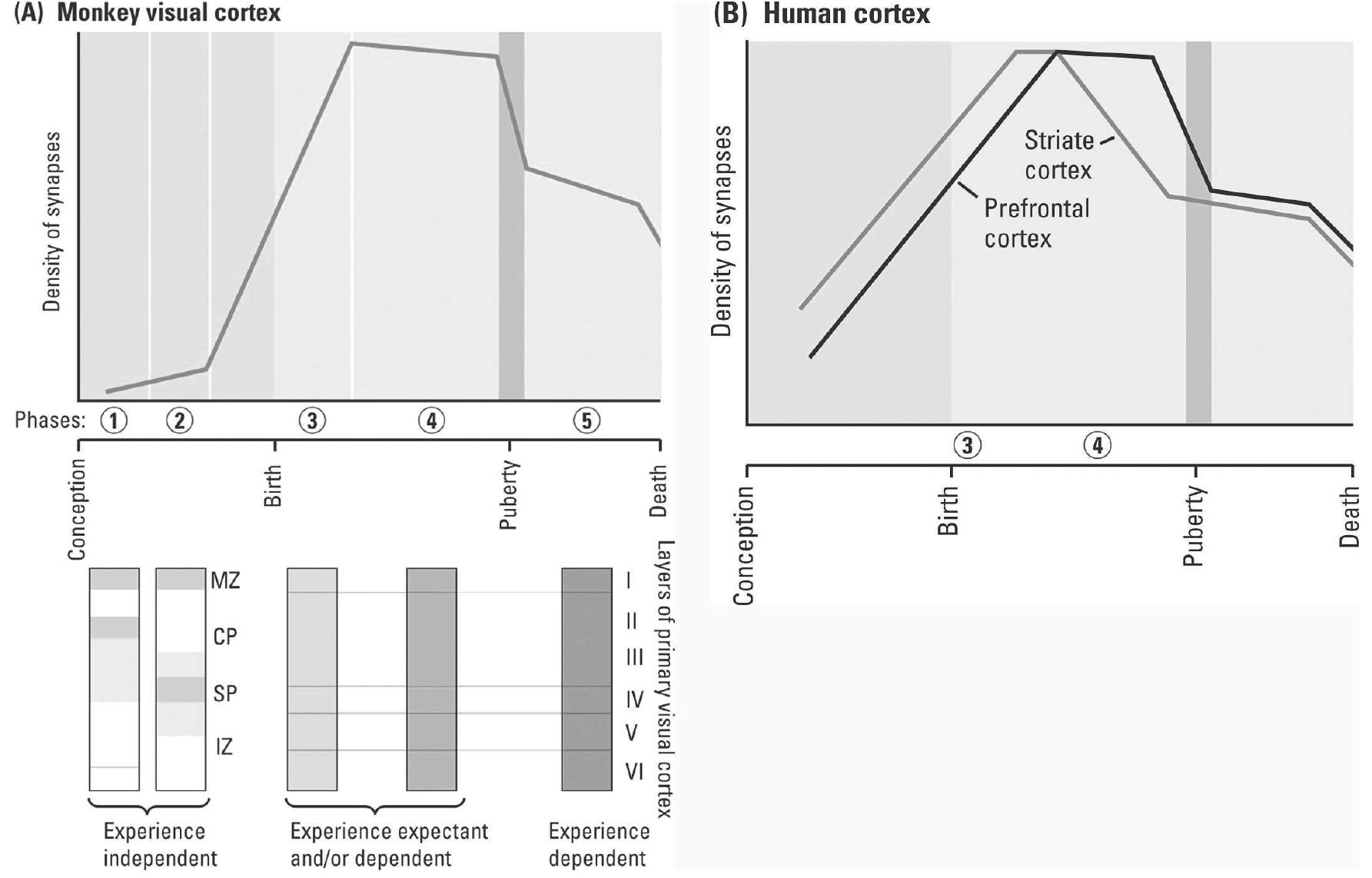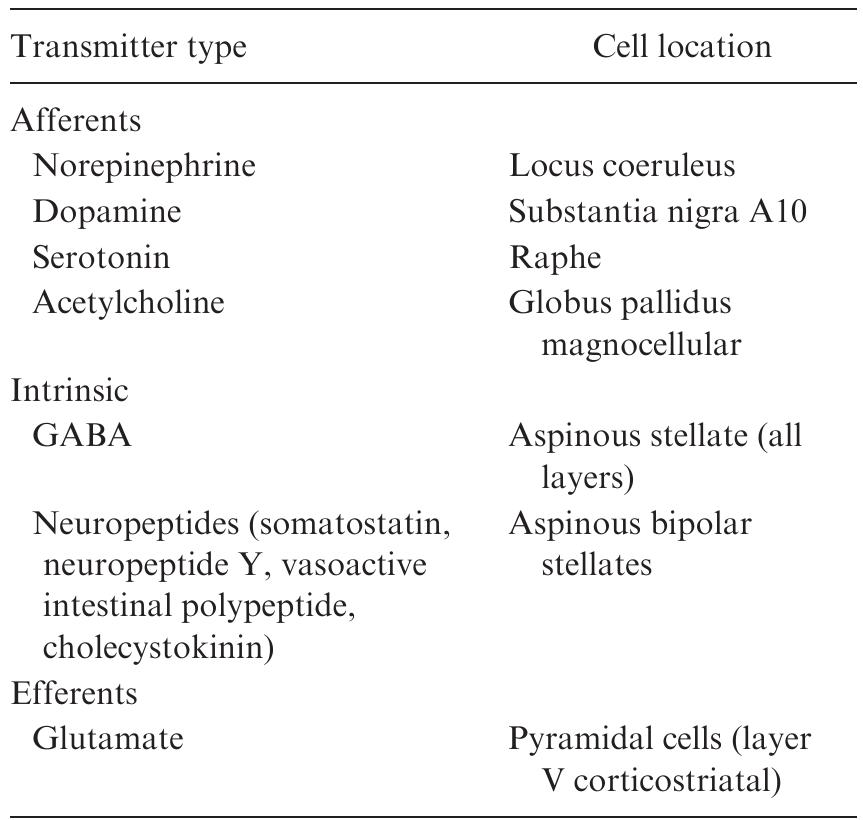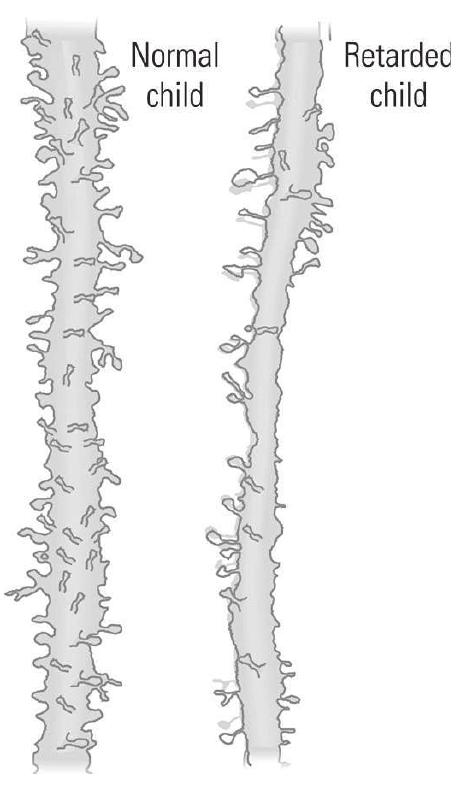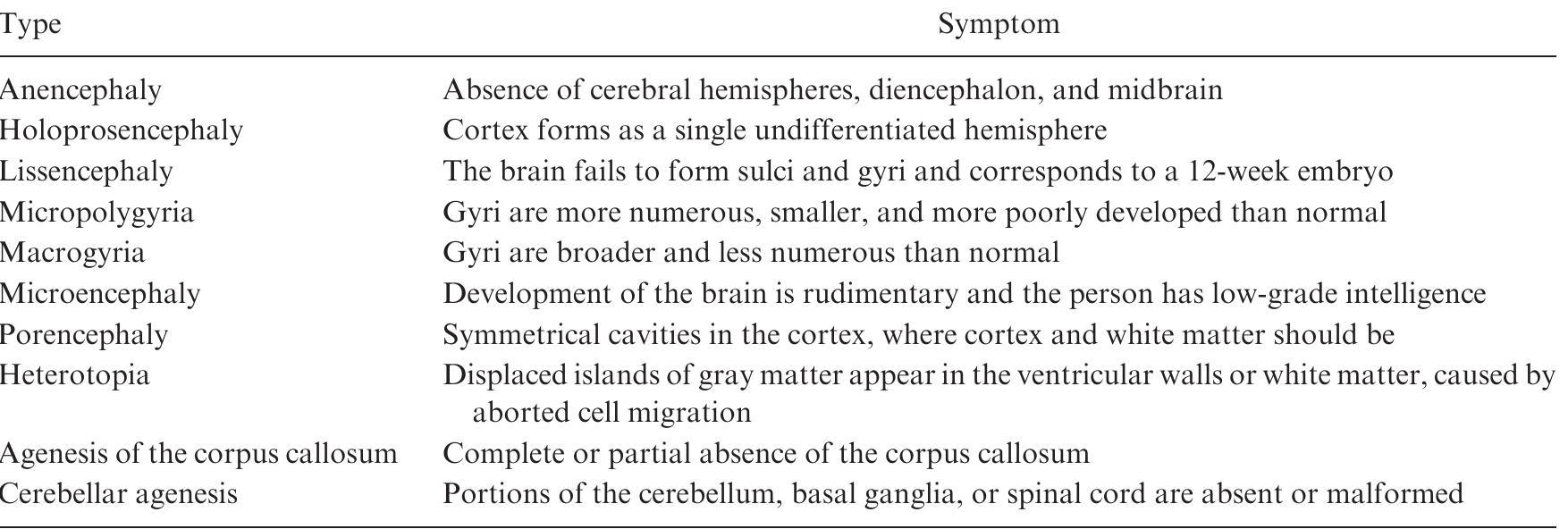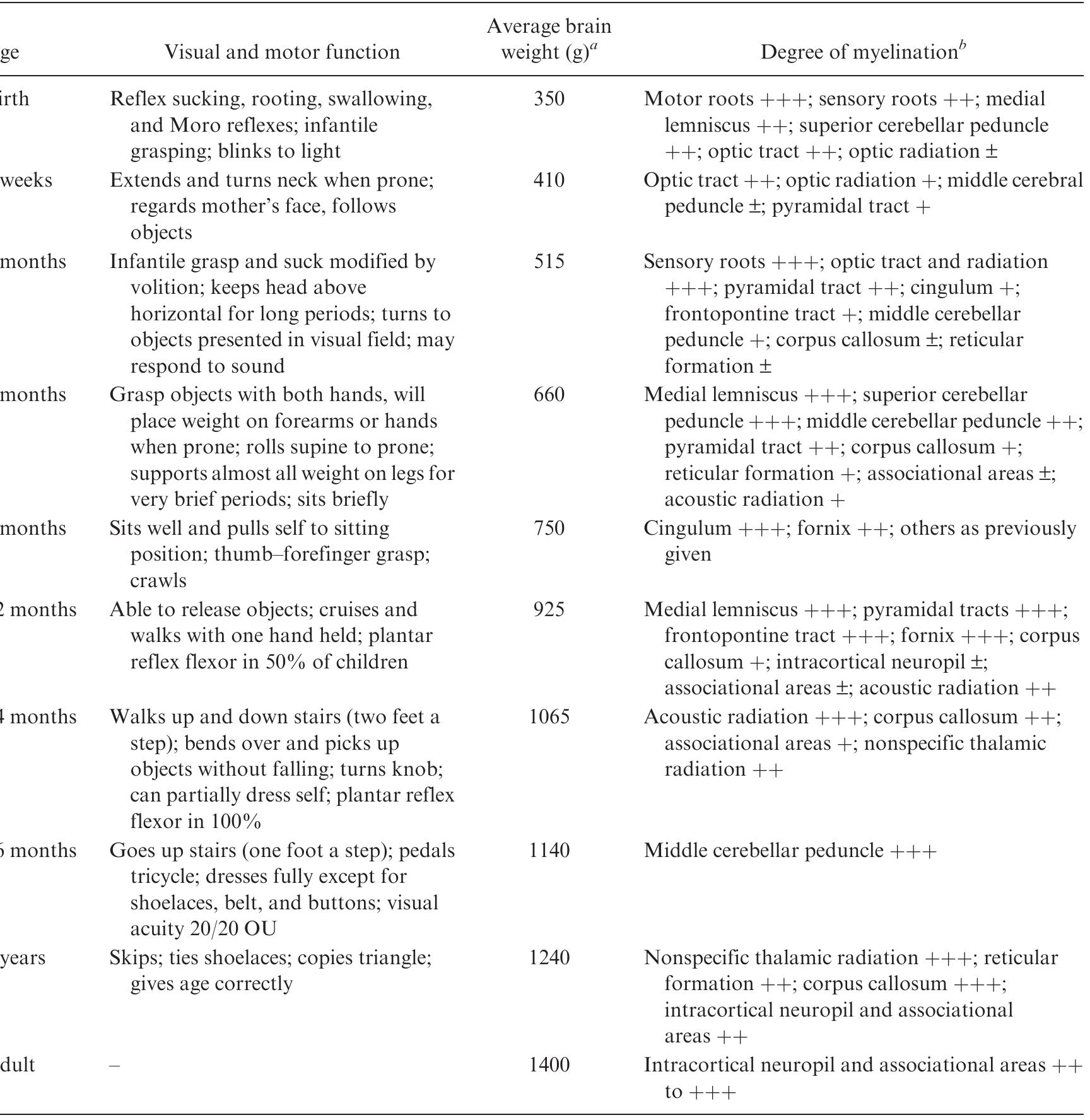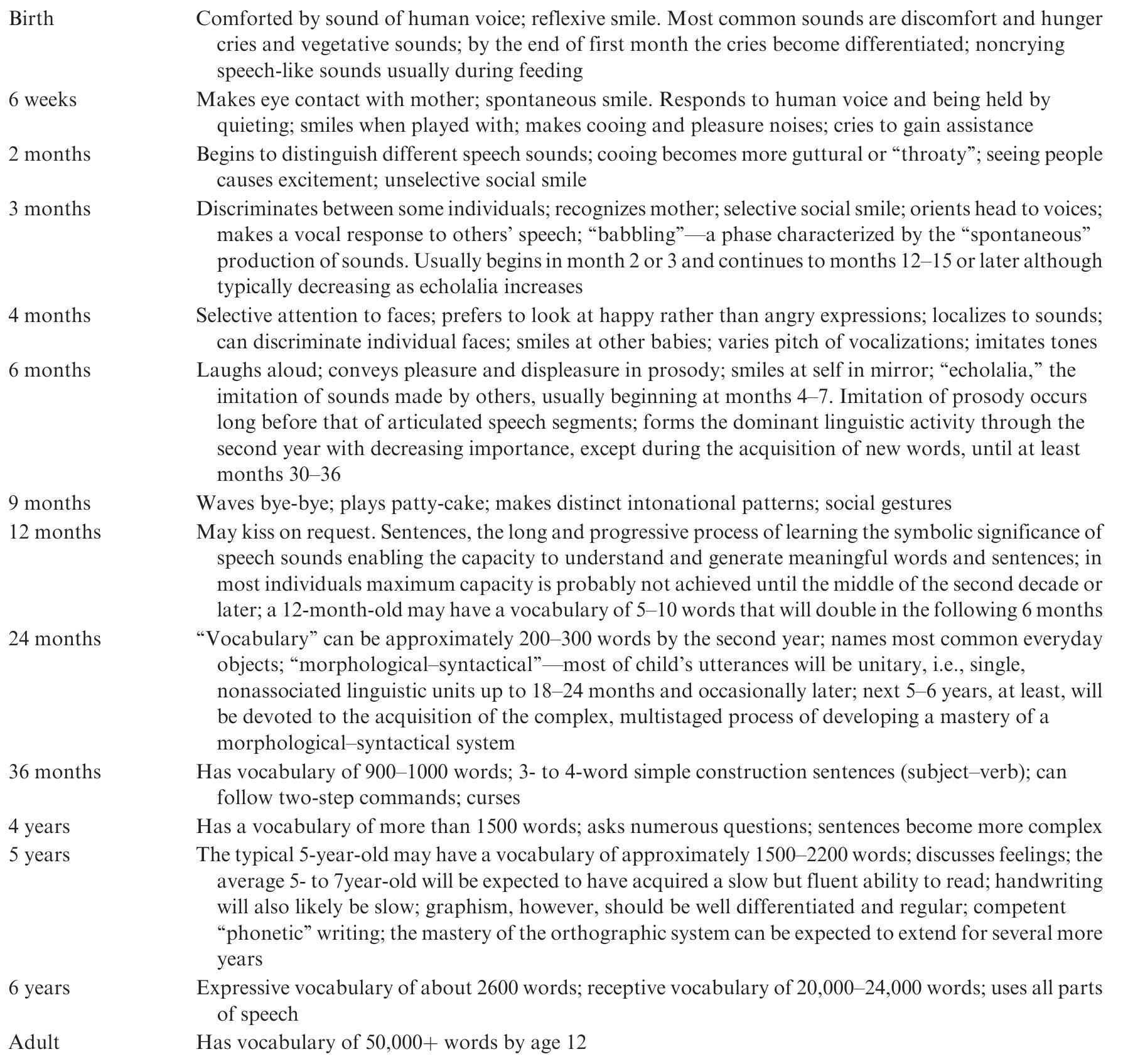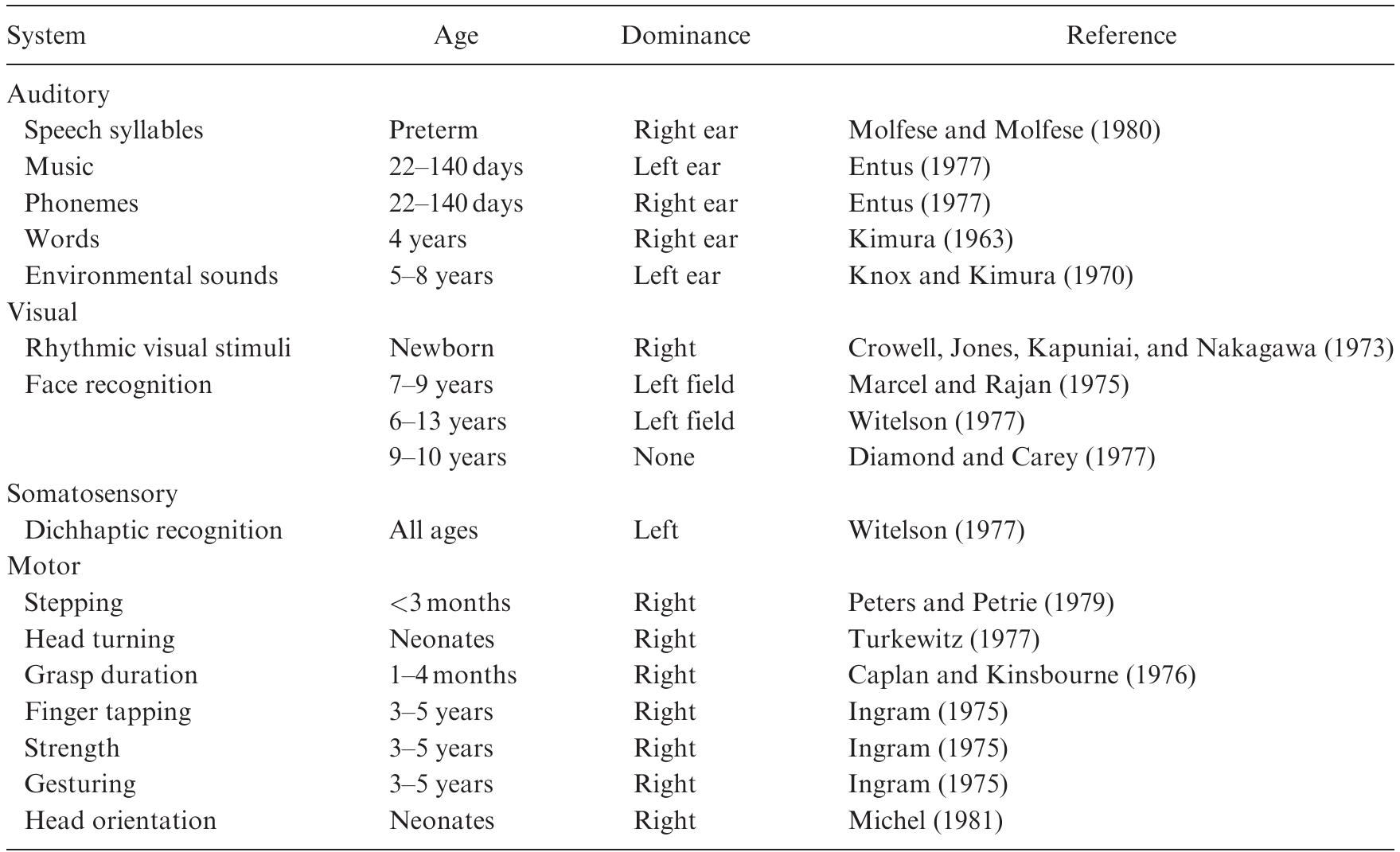Development of the child's brain and behavior (original) (raw)
Abstract
AI
The development of children's brains and behaviors has long intrigued neuropsychologists, focusing on how psychological functions manifest in the brain. The paper outlines three major approaches to studying the structure-function relationships of development, highlighting the challenges of linking neural maturation directly to behavioral changes. Notably, historical reluctance to include biological aspects in psychological theories is examined, alongside a comprehensive review of developmental milestones and their correlation to brain structure. The significance of environmental factors in shaping behavior amidst the maturation of the nervous system is emphasized, suggesting that behavior cannot solely be attributed to neural development.
FAQs
AI
What are the stages of brain development in children?add
The brain develops through neurogenesis, cell migration, differentiation, pruning, and myelination, completed by age 15.
How does myelination influence cognitive development in children?add
Myelination of sensory and motor areas begins prenatally and continues until age 15, impacting cognitive skill acquisition.
What role do environmental factors play in neural development?add
Environmental stimulation significantly influences dendritic development and functional outcomes, altering synaptic density and organization.
How does early brain injury affect cognitive functions in children?add
Injuries before age 5 can lead to functional reorganization, preserving language abilities but impairing nonverbal skills.
What correlates exist between brain structure and language development?add
Language acquisition corresponds with increased synaptic density and dendritic complexity, especially in the temporal and frontal lobes.
Figures (12)
FIGURE 2. Prenatal development of the human brain showing a series of embryonic and fetal stages. (Adapted from Cowan, 1979.) is composed of four embryonic regions: the ventricular, marginal, intermediate, and sub- ventrical zones (as illustrated in Figure 3). These zones are transient features uniquely related to early development for each either disappears or Sidman and Rakic (1973) combined the extensive studies of Poliakov (1949, 1961, 1965) with their own observations to produce a
FIGURE 1. Stages of brain development.
“From Marin-Padilla (1970) b Key: 0, unrecognizable; +, immature; ++, developing; +++, established; ++++, fully developed TABLE 1. Sequential Lamination of the Human Motor Cortex in Ontogenesis“”
FIGURE 3. Schematic representations of the pattern of neu- ral migration along the radial glial cells (after Rakic, 1981). Migrating neurons leave the ventricular and subventricular zones and travel to more superficial layers. En route they pass through the deeper neurons, which are already in place.
FIGURE 4. Postnatal development of human cerebral cortex around Broca’s area as taken from camera lucida drawings of Golgi-Cox preparations (from Conel, 1939-1967)
FIGURE 5. (A) Phases of synapse formation and pruning. Five different phases of synaptogenesis are identified between conception and death. The shading in the vertical bars indicates the areas of synapse formation during each phase. (B) Changes in the relative density of synapses in the visual cortex and prefrontal cortex as a function of days after conception. (After Bourgeois, 2001; Huttenlocher, 1984, 1990) ——__— 2’
TABLE 2. Neocortical Neurotransmitters® “After Coyle (1982).
FIGURE 6. Camera lucida representations of Golgi pre- parations showing typical dendritic segments of medium- sized pyramidal neurons. Left: Example of apical segment from a normal 7-year-old child (accident case). Right: Example of apical segment from a 12-year-old profoundly retarded child. (After Purpura, 1974.)
TABLE 3. Types of Abnormal Development Isseroff, Schwartz, & Bugbee, 1983). Similarly, Kolb and his colleagues have found abnormal corticostriatal and subcorticocortical connec- tions, abnormal myelination, altered cortical catecholamine distribution, thalamic shrinkage, reduced gliosis relative to animals with similar injuries in adulthood, and markedly thinner cor- tex following early frontal lesions in rats (for a review, see Kolb, 1995). The thin cortex appears to result both from a loss in the number of cortical cells and from a loss in dendritic arbor- ization. In sum, there is good reason to presume that early damage to the human brain produces significant changes in cortical morphology that extend far beyond the boundaries of the tissue directly traumatized. 1 ae, We . 4 mutant. Caviness (Caviness, 1982; Caviness & Rakic, 1978; Caviness & Sidman, 1973) 173) showed that in this a in this animal the cortex is inverted relative to that of a normal mouse; the cells generated first lie nearest to the cortical surface and those generated last lie deepest. In addition, many of the pyramidal cells are abnormally oriented, in some cases with their major dendrites (the apical dendrites) oriented downward rather than upward as in the normal mouse. Despite their aberrant position, the cells develop connections as they would have had they been normally situ- ated. Caviness and his colleagues studied the cortex of humans with various similar abnorm- alities, finding some of the same aberrant fea- tures (Caviness & Williams, 1979). Thus, in lissencephalic cortex, Williams, Ferrante, and Caviness (1975) found that cells failed to migrate into the appropriate layers and some cells were abnormally oriented, much as in the reeler mouse.
‘Source: Spreen, Tupper, Risser, Tuokko, & Edgell (1984). From Yakovlev and Lecours (1967). Estimates are made from their graphic data (+, minimal amounts; +, mild; ++, moderate; +++, heavy) TABLE 4. Summary of Postnatal Human Development
“Adapted from Lecours (1975) and Owens (1984). TABLE 5. Summary of Postnatal Development of Basic Social and Language Functions“
TABLE 6. Studies Showing Age of Asymmetry for Different Behaviors

Loading Preview
Sorry, preview is currently unavailable. You can download the paper by clicking the button above.
References (135)
- Ackerly, S. S. (1964). A case of prenatal bilateral frontal lobe defect observed for thirty years. In J. M. Warren, & K. Ackert (Eds.), Frontal granular cortex and behavior (pp. 192-218). New York: McGraw-Hill.
- Alajouanine, T., & Lhermitte, F. (1965). Acquired aphasia in children. Brain 88, 653-662.
- Arlin, P. K. (1975). Cognitive development in adulthood: A fifth stage? Developmental Psychology, 11(5), 602-606.
- Aram, D. M. (1988) Language sequelae of unilateral brain lesions in children. In F. Plum (Ed.), Language Com- munication and the Brain (pp. 171-197). New York: Raven Press.
- Akshoomoff, N. A., Feroleto, C. C., Doyle, R. E., & Stiles, J. (2002). The impact of early unilateral brain injury on perceptual organization and visual memory. Neuropsy- chologia, 40, 539-561.
- Banich, M. T., Cohen-Levine, S., Kim, H., & Huttenlocher, P. (1990). The effects of developmental factors on I.Q. in hemiplegic children. Neuropsychologia, 28, 35-47.
- Barlow, T. (1877) On a case of double hemiplegia with cere- bral symmetrical lesions. British Medical Journal, 2, 103-104.
- Bartzokis, G., Beckson, M., Po, H. L., Nuechterlein, N. E., & Mintz, J. (2001). Age-related changes in frontal and temporal volumes in men: A magnetic resonance ima- ging study. Archives of General Psychiatry, 58, 461-465.
- Bates, E., & Thal, D. (1991) Associations and dissociations in language development. In J. Miller (Ed.), Research on child language disorders: A decade of progress (pp. 145-168). Austin, TX: ProEd.
- Bates, E. Thal, D., Trauner, D., Fenson, J., Aram, D., Eisele, J., et al. (1997) From first words to grammar in children with focal brain injury. Developmental Neuropsychol- ogy, 13, 275-343.
- Bergstrom, R. M. (1969). Electrical parameters of the brain during ontogeny. In R. J. Robinson (Ed.), Brain and early behavior (pp. 15-37). New York: Academic Press.
- Berry, M. (1982). Cellular differentiation: Development of dendritic arborizations under normal and experimen- tally altered conditions. Neurosciences Research Pro- gram Bulletin, 20(4), 451-461.
- Bourgeois, J.-P. (2001). Synaptogenesis in the neocortex of the newborn: The ultimate frontier for individuation? In C. A. Nelson, & M. Luciana (Eds.), Handbook of developmental cognitive neuroscience. Cambridge, MA: MIT Press.
- Broca, P. (1865) Sur la siege de la faculte du langage articule dans l'hemisp;here gauche du cerveau. Bulletins de la Scoiete d'Anthropologie, 6, 377-393.
- Caplan, P. J., & Kinsbourne, M. (1976). Baby drops the rattle: Asymmetry of duration of grasp by infants. Child Development, 47, 532-534.
- Carey, S. (1984). Cognitive development: The descriptive pro- blem. In M. S. Gazzaniga (Ed.), Handbook of cognitive neuroscience (pp. 37-66). New York: Plenum Press.
- Carey, S., Diamond, R., & Woods, B. (1980). Development of face recognition-A maturational component? Developmental Psychology, 16(6), 257-269.
- Carlsson, G., & Hugdahl, K. (2000) Cerebral reorganiza- tion in children with congenital hemiplegia: Evidence from the dichotic listening test. In H. S. Levin, & J. Grafman (Eds.), Cerebral Reorganization of Func- tion After Brain Damage (pp. 232-246). New York: Oxford.
- Carr, L. J. (2000) Reorganization of motor function in cere- bral palsy. In H. S. Levin, & J. Grafman (Eds.), Cere- bral reorganization of function after brain damage (pp. 247-262). New York: Oxford.
- Case, R. (1992). The role of the frontal lobes in the regulation of cognitive development. Brain and Cognition, 20, 51-73.
- Caveness, W. F. (1969). Ontogeny of focal seizures. In H. H. Jasper, A. A. Ward, Jr., & A. Pope (Eds.), Basic mechanisms of the epilepsies (pp. 517-534). Boston: Lit- tle, Brown.
- Caviness, V. S., Jr. (1982). Development of neocortical affer- ent systems: Studies in the reeler mouse. Neurosciences Research Program Bulletin, 20(4), 560-569.
- Caviness, V. S., & Rakic, P. (1978). Mechanisms of cortical development: A view from mutations in mice. Annual Review of Neuroscience, 1, 297-326.
- Caviness, V. S., Jr., & Sidman, R. L. (1973). Time of origin of corresponding cell classes in the cerebral cortex of normal and reeler mutant mice: An autoradiographic analysis. Journal of Comparative Neurology, 148, 141-152.
- Caviness, V. S., & Williams, R. S. (1979). Cellular pathology of developing human cortex. Research Publications of the Association for Research in Nervous and Mental Diseases, 57, 69-98.
- Chi, J. G., Dooling, E. C., & Gilles, F. H. (1977). Left-right asymmetries of the temporal speech areas of the human fetus. Archives of Neurology, 34, 346-348.
- Chugani, H. T., & Phelps, M. E. (1986). Maturational changes in cerebral function in infants determined by 18 FDG positron emission tomography. Science, 231, 840-843.
- Clancy, B., Kersh, B., Hyde, J., Darlington, R.B., Anand, K.J., & Finlay, B.L. (2007) Web-based method for translating neurodevelopment from laboratory species to humans. Neuroinformatics, 5, 79-94.
- Conel, J. L. (1939-1967). The postnatal development of the human cerebral cortex (Vols. I-VIII). Cambridge, MA: Harvard University Press.
- Cowan, W. M. (1979). The development of the brain. Scien- tific American, 241, 112-133.
- Cragg, B. G. (1975). The density of synapses and neurons in normal, mentally defective and ageing human brains. Brain, 98, 81-90.
- Crowell, D. H., Jones, R. H., Kapuniai, L. E., & Nakagawa, J. K. (1973). Unilateral cortical activity in newborn humans: An early index of cerebral dominance? Science, 180, 205-208.
- Dennett, D.C. (1995). Darwin's dangerous idea: Evolution and the meanings of life. New York: Simon & Schuster.
- Diamond, R., & Carey, S. (1977). Developmental changes in the representation of faces. Journal of Experimental Child Psychology, 23, 1-22.
- Drake, W. (1968). Clinical and pathological findings in a child with a developmental learning disability. Journal of Learning Disabilities, 1, 468-475.
- Entus, A. K. (1977). Hemispheric asymmetry in processing of dichotically presented speech and nonspeech stimuli by infants. In S. J. Segalowitz, & F. A. Gruber (Eds.), Language development and neurological theory (pp. 63-73). New York: Academic Press.
- Epstein, H. T. (1978). Growth spurts during brain develop- ment: Implications for educational policy and practice. In J. S. Chall, & A. F. Mirsky (Eds.), Education and the brain (pp. 343-370). Chicago: University of Chicago Press.
- Epstein, H. T. (1979). Correlated brain and intelligence development in humans. In M. E. Hahn, C. Jensen, & B. C. Dudek (Eds.), Development and evolution of brain size: Behavioral implications (pp. 111-131). New York: Academic Press.
- Eslinger, P. J., & Damasio, A. R. (1985). Severe disturbance of higher cognition after bilateral frontal lobe ablation: Patient EVR. Neurology, 35, 1731-1741.
- Farmer, S. F., Harrison, L. M., Ingram, D. A., & Stephens, J. A. (1991). Plasticity of central motor path- ways in children with hemiplegic cerebral palsy. Neurol- ogy, 41, 1505-1150.
- Flechsig, P. (1920). Anatomie des menschlichen Gehirns und Ruckenmarks. Leipzig: Thieme.
- Galaburda, A. M., & Eidelberg, D. (1982). Symmetry and asymmetry in the human posterior thalamus. II. Tha- lamic lesions in a case of development dyslexia. Archives of Neurology, 39, 333-336.
- Galaburda, A. M., & Kemper, T. L. (1979). Cytoarchitec- tonic abnormalities in developmental dyslexia: A case study. Annals of Neurology, 6, 94-100.
- Geschwind, N., & Galaburda, A. M. (1985). Cerebral later- alization: Biological Mechanisms, associations, and pathology. 1. A hypothesis and a program for research. Archives of Neurology, 42, 428-459.
- Gibson, K. R. (1977). Brain structure and intelligence in macaques and human infants from a Piagetian perspec- tive. In S. Chevalier-Skolnikoff, & F. E. Poirer (Eds.), Primate biosocial development: Biological, social, and ecological determinants (pp. 113-157). New York: Garland.
- Goldman, P. S. (1974). An alternative to developmental plasticity: Heterology of CNS structures in infants and adults. In D. G. Stein, J. J. Rosen, & N. Butters (Eds.), Plasticity and recovery of function in the central nervous system (pp. 149-174). New York: Academic Press.
- Goldman, P. S., & Galkin, T. W. (1978). Prenatal removal of frontal association cortex in the fetal rhesus monkey: Anatomical and functional consequences in postnatal life. Brain Research, 152, 451-485.
- Goldman-Rakic, P. S., & Brown, R. M. (1981). Regional changes of monoamines in cerebral cortex and subcor- tical structures of aging rhesus monkeys. Neuroscience, 6, 177-187.
- Goldman-Rakic, P. S., & Brown, R. M. (1982). Postnatal development of monoamine content and synthesis in the cerebral cortex of rhesus monkeys. Developmental Brain Research, 4, 339-349.
- Goldman-Rakic, P. S., Isseroff, A., Schwartz, M. L., & Bugbee, N. M. (1983). The neurobiology of cognitive development. In P. Mussen (Ed.), Handbook of child psychology: Biology and infancy development (pp. 281-344). New York: Wiley.
- Gogtay, N., Gledd, J. M. N., Lusk, L., Hayashi, K.M., Greenstein, D., Valtuzis, A. C., et al. Dynamic mapping of human cortical development during childhood and adolescence. Proceedings of the National Academy of Sciences, 101, 8174-8179, 2004.
- Gould, E. (2007) How widespread is adult neurogenesis in mammals? Nature Reviews Neuroscience, 8: 481-488.
- Gould, S. J. & Lewontin, R. (1979). The spandrels of San Marco and the Panglossian Paradigm: A critique of the adaptationist programme. Proceedings of the Royal Society, B205,581-598.
- Grattan, L. M., & Eslinger, P. J. (1992). Long-term psycho- logical consequences of childhood frontal lobe lesion in patient DT. Brain and Cognition, 20, 185-195.
- Greenough, W. T. (1976). Enduring brain effects of differen- tial experience and training. In M. R. Rosenzweig, & E. L. Bennett (Eds.), Neural mechanisms of learning and memory (pp. 255-278). Cambridge, MA: MIT Press.
- Hebb, D. O. (1949). Organization of behavior. New York: Wiley.
- Hicks, S. P., Damato, C. J., & Lowe, M. J., (1959).The development of the mammalian nervous system. Mal- formations of the brain, especially the cerebral cortex, induced in rats by radiation. Journal of Comparative Neurology, 113, 435-453.
- Holloway, V., Gadian, D., Vargha-Khadem, F., Porter, D. A., Boyd, S.G., & Connelly, A. (2000). The reorganization of sensorimotor function in children after hemispherectomy. Brain, 123, 2432-2444.
- Hubel, D. H., & Wiesel, T. N. (1970). The period of suscept- ibility to the physiological effects of unilateral eye clo- sure in kittens. Journal of Physiology (London), 206, 419-436.
- Huttenlocher, P.R. (1984). Synapse elimination and plasti- city in developing human cerebral cortex. American Journal of Mental Deficiency, 88, 488-496.
- Huttenlocher, P.R. (1990). Morphometric study of human cer- ebral cortex development. Neuropsychologia, 28, 517-527.
- Ingram, D. (1975). Motor asymmetries in young children. Neuropsychologia, 13, 95-102.
- Jacobsen, M. (1978). Developmental neurobiology (2 nd ed.). New York: Plenum Press.
- Juraska, J. (1990). The structure of the rat cerebral cortex: Effects of gender and environment. In B. Kolb, & R. Tees (Eds.), Cerebral cortex of the rat (pp. 483-506). Cambridge, MA: MIT Press.
- Kimura, D. (1963). Speech lateralization in young children as determined by an auditory test. Journal of Comparative and Physiological Psychology, 56, 899-902.
- Knox, C., & Kimura, D. (1970). Cerebral processing of non- verbal sounds in boys and girls. Neuropsychologia, 8, 227-237.
- Kolb, B. (1995). Brain plasticity and behavior. Hillsdale, NJ: Lawrence Erlbaum.
- Kolb, B., & Fantie, B. (1989). Development of the child's brain and behavior. In C. R. Reynolds, & E. Fletcher- Janzen (Eds.), Handbook of clinical child neuropsychol- ogy (pp. 17-39). New York: Plenum Press.
- Kolb, B., & Milner, B. (1981). Performance of complex arm and facial movements after focal brain lesions. Neurop- sychologia, 19, 491-503.
- Kolb, B., & Taylor, L. (1981). Affective behavior in patients with localized cortical excisions: Role of lesion site and side. Science, 214, 89-91.
- Kolb, B., & Taylor, L. (1990). Neocortical substrates of emotional behavior. In N. L. Stein, B. Levethal, & T. Trabasso, (Eds.), Psychological and biological approaches to emotion (pp. 115-144). Hillsdale, NJ: Erlbaum.
- Kolb, B., & Whishaw, I. Q. (2008). Fundamentals of human neuropsychology (6th ed.). New York: Freeman.
- Kolb, B., Wilson, B., & Taylor, L. (1992). Developmental changes in the recognition and comprehension of facial expression: Implications for frontal lobe function. Brain and Cognition, 20, 74-84.
- Krashen, S. D. (1973). Lateralization, language learning, and the critical period: Some new evidence. Language Learning, 23, 63-74.
- Lecours, A. R. (1975). Myelogenetic correlates of the devel- opment of speech and language. In E. H. Lenneberg, & E. Lenneberg (Eds.), Foundations of language develop- ment: A multidisciplinary approach (Vol. 1, pp. 121-135). New York: Academic Press.
- Lenneberg, E. H. (1967). Biological foundations of language. New York: Wiley.
- LeVere, N. D., Gray-Silva, S., & Le Vere, T. E. (1988) Infant brain injury: The benefit of relocation and the cost of crowding. In S. Finger, T. E. LeVEre, C. R. Almili, & D. G. Stein (Eds.), Brain injury and recovery- theoretical and controversial issues (pp. 133-150). New York: Plenum Press.
- Levin, H. S., Scheller, J., Rickard, T., Grafman, J., Martin- kowski, K., Winslow, M., et al. (1996) Dyscalculia and dyslexia after right hemisphere injury in infancy. Archives of Neurology, 53, 88-96.
- Levin, H. S., Song, J., Chapman, S. B., & Howard, H. (2000). In H. S. Levin, & J. Grafman (Eds.), Cerebral reorga- nization of function after brain damage (pp. 218-231). New York: Oxford.
- Lezak, M. D., Howieson, D. B., Loring, D.W., Hannay. H.J., & Fischer, J. S. (2004). Neuropsychological assessment (4th ed.). New York: Oxford University Press.
- Marcel, T., & Rajan, P. (1975). Lateral specialization for recognition of words and faces in good and poor read- ers. Neuropsychologia, 13, 489-497.
- Marin-Padilla, M. (1970). Prenatal and early postnatal onto- genesis of the motor cortex: A Golgi study. 1. The sequential development of cortical layers. Brain Research, 23, 167-183.
- Marin-Padilla, M. (1988). Early ontogenesis of the human cerebral cortex. In A. Peters, & E. G. Jones (Eds.), Cerebral cortex (Vol. 7, pp. 1-34). New York: Plenum Press.
- Michel, G. F. (1981). Right handedness: A consequence of infant supine head-orientation preference? Science, 212, 685-687.
- Miller M. W. (1986). Effects of alcohol on the generation and migration of cerebral cortical neurons. Science, 233, 1308-1311.
- Milner, B. (1964). Some effects of frontal lobectomy in man. In J. M. Warren, & K. Akert (Eds.), The frontal gran- ular cortex and behavior (pp. 313-334). New York: McGraw-Hill.
- Molfese, D. L., & Molfese, V. J. (1980). Cortical responses of preterm infants to phonetic and nonphonetic speech stimuli. Developmental Psychology, 16(6), 574-581.
- Molfese, D. L., & Segalowitz, S. J., (1988). Brain lateraliza- tion in children: Developmental implications. New York: Guildford.
- Nass, R., de Coudres-Peterson, H.D., & Koch, D. (1989) Differential effects of congenital left and right brain injury on intelligence. Brain and Cognition, 9, 253-259.
- Nelson, C. A., & Luciana, M. (2008) Handbook of develop- mental cognitive neuroscience (2 nd ed.). Cambridge, MA: MIT Press.
- Owens, R. E., Jr. (1984). Language development: An introduc- tion.
- Columbus, OH: Charles E. Merrill Publishing.
- Parnavelas, J. G., Papadopoulos, G. C., & Cavanagh, M. E. (1988). Changes in neurotransmitters during develop- ment. In A. Peters, & E. G. Jones (Eds.), Cerebral cortex (Vol. 7, pp. 177-209). New York: Plenum Press.
- Peiper, A. (1963). Cerebral function in infancy and childhood. New York: Consultants Bureau.
- Peters, M., & Petrie, B. J. F. (1979). Functional asymmetries in the stepping reflex of human neonates. Canadian Journal of Psychology, 33, 198-200.
- Piaget, J. (1952). The origins of intelligence in children. New York: Norton.
- Poliakov, G. I. (1949). Structural organization of the human cerebral cortex during ontogenetic development. In S. A. Sarkisov, I. N. Filimonov, & N. S. Preobrazenskaya (Eds.), Cytoarchitectonics of the cerebral cortex in man (pp. 33-92). Moscow: Medgiz (In Russian).
- Poliakov, G. I. (1961). Some results of research into the development of the neuronal structure of the cortical ends of the analyzers in man. Journal of Comparative Neurology, 117, 197-212.
- Poliakov, G. I. (1965). Development of the cerebral neocor- tex during first half of intrauterine life. In S. A. Sarko- sov (Ed.), Development of the child's brain (pp. 22-52). Leningrad: Medicina. (In Russian)
- Purpura, D. P. (1974). Dendritic spine ''dysgenesis'' and mental retardation. Science, 186, 1126-1127.
- Purpura, D. P. (1976). Structure-dysfunction relations in the visual cortex of preterm infants. In M. A. B. Braxier
- & F. Coceani (Eds.), Brain dysfunction in infantile febrile convulsions (pp. 223-240). New York: Raven Press.
- Purpura, D. P. (1982). Normal and abnormal development of cerebral cortex in man. Neurosciences Research Pro- gram Bulletin, 20(4), 569-577.
- Rakic, P. (1972). Mode of cell migration to the superficial layers of fetal monkey neocortex. Journal of Compara- tive Neurology, 145, 61-84.
- Rakic, P. (1975). Timing of major ontogenetic events in the visual cortex of the rhesus monkey. In N. A. Buchwald & M. Brazier (Eds.), Brain mechanisms in mental retarda- tion (pp. 3-40). New York: Academic Press.
- Rakic, P. (1976). Prenatal genesis of connections subserving ocular dominance in the rhesus monkey. Nature, 261, 467-471.
- Rakic, P. (1981). Developmental events leading to laminar and areal organization of the neocortex. In F. O. Schmitt, F. G. Worden, G. Adelman, & S. G. Dennis (Eds.), The organization of the cerebral cortex (pp. 7-8). Cambridge, MA: MIT Press.
- Rakic, P. (1984). Defective cell-to-cell interactions as causes of brain malformations. In E. S. Gollin (Ed.), Malfor- mations of development-Biological and psychological sources and consequences (pp. 239-285). New York: Academic Press.
- Rasmussen, T., & Milner, B. (1977). The role of early left- brain injury in determining lateralization of cerebral speech functions. Annals of the New York Academy of Sciences, 299, 355-369.
- Reilly, J. S., Bates, E., & Marchman, V. (1998) Narrative discourse in children with early focal brain injury. Brain and Language, 61, 335-375.
- Riva, D., & Cazzaniga, L. (1986) Late effects of unilateral brain lesions sustained before and after age one. Neuro- psychologia, 24, 423-428.
- Robinson, R. J. (1966). Cerebral function in the newborn child. Developmental Medicine and Child Neurology, 8, 561-567.
- Satz, P., Strauss, E., Hunter, M., & Wada, J. (1994) Re- examination of the crowding hypothesis: Effects of age and onset. Neuropsychologia, 8, 255-262.
- Segalowitz, S. J., & Rose-Krasnor, L. (1992). The construct of brain maturation in theories of child development, Brain and Cognition, 20, 1-7.
- Sidman, R. L., & Rakic, P. (1973). Neuronal migration, with special reference to developing human brain: A review. Brain Research, 62, 1-35.
- Spreen, O., Tupper, D., Risser, A., Tuokko, H., & Edgell, D. (1984). Human developmental neuropsychology. Lon- don: Oxford University Press.
- Stewart, J., & Kolb, B. (1994). Dendritic branching in corti- cal pyramidal cells in response to ovariectomy in adult female rats: Suppression by neonatal exposure to tes- tosterone. Brain Research, 654, 149-154.
- Stiles, J. (2000) Spatial cognitive development following prenatal or perinatal focal brain injury. In H. S. Levin, & J. Grafman (Eds.) Cerebral reorganization of function after brain damage (pp. 201-217). Oxford: New York.
- Stiles, J., Trauner, D., Engle, M., & Nass, R. (1997). The development of drawing in children with congenital focal brain injury: Evidence for limited functional recovery. Neuropsychologia, 35, 299-312.
- Stiles, J., Reilly, J., Paul, B., & Moses, P. (2005). Cognitive development following early brain injury: evidence for neural adaptation. Trends in Cognitive Science, 9, 136-143.
- Stoltenburg-Didinger G., & Markwort S. (1990). Prenatal methylmercury exposure results in dendritic spine dys- genesis in rats. Neurotoxicology and Teratology, 12(6), 573-576.
- Strauss, E., Satz, P., & Wada, J. (1990). An examination of the crowding hypothesis in epileptic patients who have undergone the carotid amytal test. Neuropsychologia, 28, 1221-1227.
- Stuss, D. T. (1992). Biological and psychological development of executive functions. Brain and Cognition, 20, 8-23.
- Sutherland, R. J., Kolb, B., Schoel, M., Whishaw, I. Q., & Davies, D. (1982). Neuropsychological assessment of children and adults with Tourette syndrome: A compar- ison with learning disabilities and schizophrenia. In A. J. Freidhoff, & T. N. Chase (Eds.), Gilles de la Tour- ette syndrome (pp. 311-322). New York: Raven Press.
- Teuber, H.-L. (1975). Recovery of function after brain injury in man. Ciba Foundation Symposium, 34, 159-186.
- Thatcher, R. W. (1992). Cyclic cortical reorganization during early childhood. Brain and Cognition, 20, 24-50.
- Turkewitz, G. (1977). The development of lateral differentia- tion in the human infant. Annals of the New York Acad- emy of Sciences, 299, 213-221.
- Twitchell, T. E. (1965). The automatic grasping responses of infants. Neuropsychologia, 3, 247-259.
- Vargha-Khadem, F., & Polkey, C. E. (1992). A review of cognitive outcome after hemidecortication in humans.
- In F. D. Rose, & D. A. Johnson (Eds.), Recovery from brain damage (pp. 137-168). New York: Plenum Press.
- Vargha-Khadem, F., Watters, G., & O'Gorman, A. M. (1985). Development of speech and language following bilateral frontal lesions. Brain and Language, 37, 167-183.
- Wada, J. A., Clarke, R., & Hamm, A. (1975). Cerebral hemi- spheric asymmetry in humans: Cortical speech zones in 100 adult and 100 infant brains. Archives of Neurology 32, 239-246.
- Werker, J. F., & Tees, R. C. (1992). The organization and reorganization of human speech perception. Annual Review of Neuroscience, 15, 377-402.
- Whishaw, I. Q., & Kolb, B. (1984). Neuropsychological assessment of children and adults with developmental dyslexia. In R. N. Malatesha, & H. A. Whitaker (Eds.), Dyslexia: A global issue (pp. 375-404). The Hague: Nijhoff.
- Williams, R. S., Ferrante, R. J., & Caviness, V. S., Jr. (1975). Neocortical organization in human cerebral malforma- tion: A Golgi study. Neuroscience Abstracts, 1, 776.

